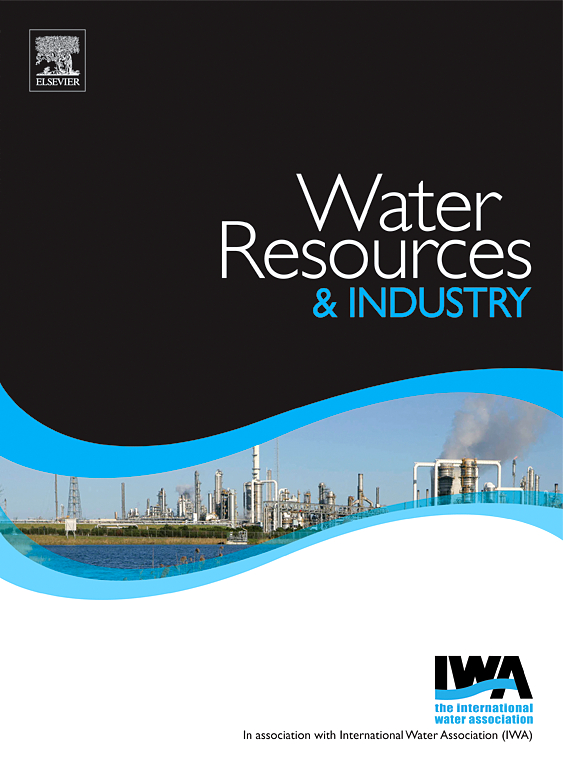Assessing water dependencies and risks in Dutch industries: Distribution, consumption and future challenges
IF 7.5
3区 工程技术
Q1 WATER RESOURCES
引用次数: 0
Abstract
This research examined the water dependencies and associated risks in Dutch industries by focusing on three main aspects: the geographical distribution of industrial clusters relative to water sources, water consumption and its economic value across different sectors, and future water stress scenarios with their regional implications. The study uncovered a complex relationship between industrial facility location and water use. It revealed a strong correlation between facilities and nearby water sources, with a tendency for industries to cluster around water sources, peaking at a proximity of about 0–5 km for both surface water and groundwater sources. However, it also pointed out that this relationship is influenced by several other factors including water quality, extraction rights, historical development, and competition for water resources. Additionally, the analysis underlined the importance of considering both water consumption and proximity to water sources to accurately assess dependency. It advocated a more sophisticated approach that moves beyond mere water usage per unit of output to encompass the production complexities that significantly affect water dependency in particular industries. The future projection showed baseline water stress impacts the security of water supply of industries at different magnitude. Particularly, North Brabant and Limburg stood out as particularly vulnerable. These regions hold a significant portion of the studied industrial facilities (21.7 %) and dominate the nation's mineral industry (75 %). The study acknowledged the drawbacks of depending solely on average sectoral data and stresses the urgency for proactive water management strategies. These insights laid a solid groundwork for further research and the implementation of targeted water conservation and sustainable production measures within the Dutch manufacturing sector and beyond as water management issues have global relevance. This study suggested areas for further exploration such as exploring different circular water strategies, industrial symbiosis, leveraging digital technology for optimising water management, and utilising alternative water sources.
评估荷兰工业对水的依赖和风险:分配、消费和未来挑战
本研究通过三个主要方面考察了荷兰工业对水的依赖和相关风险:相对于水源的产业集群的地理分布,不同部门的用水量及其经济价值,以及未来水资源压力情景及其区域影响。这项研究揭示了工业设施位置和用水之间的复杂关系。研究表明,设施与附近水源之间存在很强的相关性,工业倾向于在水源周围聚集,地表水和地下水水源在大约0-5公里附近达到峰值。然而,该报告也指出,这种关系受到其他几个因素的影响,包括水质、开采权、历史发展和对水资源的竞争。此外,分析强调了同时考虑用水量和靠近水源的重要性,以便准确评估依赖性。它提倡一种更复杂的方法,超越仅仅是每单位产出的用水量,而包括对特定工业的用水依赖有重大影响的生产复杂性。未来预测显示,基线水资源压力对工业供水安全的影响程度不同。北布拉班特和林堡尤其脆弱。这些地区拥有所研究的工业设施的很大一部分(21.7%),并主导着全国的矿产工业(75%)。该研究承认了仅仅依赖平均部门数据的缺点,并强调了积极主动的水资源管理战略的紧迫性。这些见解为荷兰制造业的进一步研究和实施有针对性的节水和可持续生产措施奠定了坚实的基础,因为水管理问题具有全球相关性。该研究提出了进一步探索的领域,如探索不同的循环水战略,工业共生,利用数字技术优化水管理,以及利用替代水源。
本文章由计算机程序翻译,如有差异,请以英文原文为准。
求助全文
约1分钟内获得全文
求助全文
来源期刊

Water Resources and Industry
Social Sciences-Geography, Planning and Development
CiteScore
8.10
自引率
5.90%
发文量
23
审稿时长
75 days
期刊介绍:
Water Resources and Industry moves research to innovation by focusing on the role industry plays in the exploitation, management and treatment of water resources. Different industries use radically different water resources in their production processes, while they produce, treat and dispose a wide variety of wastewater qualities. Depending on the geographical location of the facilities, the impact on the local resources will vary, pre-empting the applicability of one single approach. The aims and scope of the journal include: -Industrial water footprint assessment - an evaluation of tools and methodologies -What constitutes good corporate governance and policy and how to evaluate water-related risk -What constitutes good stakeholder collaboration and engagement -New technologies enabling companies to better manage water resources -Integration of water and energy and of water treatment and production processes in industry
 求助内容:
求助内容: 应助结果提醒方式:
应助结果提醒方式:


